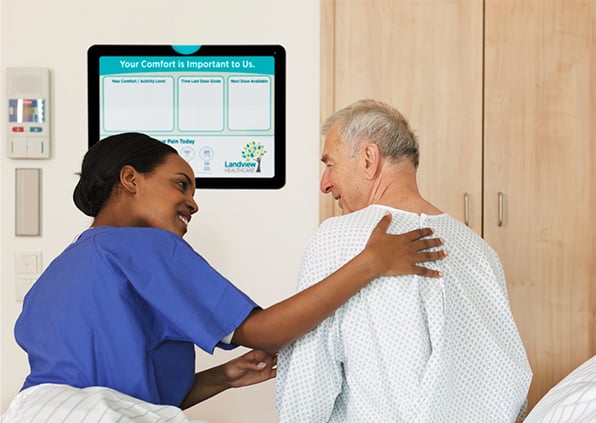One of the biggest trends in healthcare in recent years has been the rise of patient engagement, sometimes known as patient participation. Indeed, 77% of people start the search for a new physician by
reading online reviews. However, as complicated as healthcare itself can be, the concept behind patient
engagement is actually quite simple:
When patients are actively involved in their own care, they will generally achieve better outcomes while spending less money.
The Aims Underlying Patient Engagement
The patient engagement phenomenon gained momentum after the publication of Crossing the Quality Chasm: A New Health System for the 21st Century in 2001. This landmark work from the National
Academy of Medicine (formerly the Institute of Medicine) called for a series of reforms in the healthcare industry. Specifically, the report focused on six “aims” for improvement and noted that healthcare should be:
Safe: Avoid injuries to patients from the care that is intended to help them.
Effective: Avoid overuse and underuse of healthcare treatments by providing services to all who could benefit and refraining from providing services to those who likely would not.
Patient-Centered: Ensure that the patient guides all clinical decisions and provide care that is respectful of individual patient preferences, needs and values.
Timely: Reduce waiting times and the sometimes harmful delays experienced by those who receive or give care.
Efficient: Avoid wasting equipment, supplies, ideas and energy.
Equitable: Provide care that does not vary in quality due to gender, ethnicity, geographic location or socioeconomic status.
Patient Engagement in Simple Terms
To fully understand what patient engagement looks like in action, it can be helpful to think of a specific scenario. The researchers at HealthAffairs.org offer the following example:
- Two patients are experiencing the same type of chronic knee pain.
- Patient A wants to pursue the most aggressive treatment possible and opts to have knee replacement surgery.
- However, Patient B is worried that surgery may not completely relieve pain or restore mobility.
- Patient B declines knee replacement surgery and chooses to address the condition through a combination of pain medication and weight loss.
Patients A and B came to opposite conclusions. And yet, it can be argued that both made the right decision. That’s because the preferences, needs and values of each patient drove the decision.
The Benefits of Patient Engagement
The key to patient engagement lies in providing the appropriate level of decision support required by each patient. A study by David Verhoff of Health Dialog found that offering “advanced decision support” to patients dramatically reduces overall costs of care, hospitalizations and surgeries. In a year-long randomized study of more than 174,000 people, patients who received enhanced telephone-based health coaching had:
- 5.3% lower overall medical costs
- 12.5% fewer hospitalizations
- 9.9% fewer “preference-sensitive” surgeries, including 20.9% fewer preference-sensitive heart surgeries
As the saying goes, knowledge is power. Even a modest amount of knowledge and counselling in the hands of patients can result in better outcomes and lower costs – a win/win for patients and healthcare providers alike. However, doing this requires thoughtful communication.
6 Strategies for Improving Patient Engagement
Phone calls. Videos. Websites. Books. Pamphlets. There are a wide variety of communication tactics that can be used to deliver the information patients need to confidently make decisions about their care. In
fact, 62% of patients value good communication and continuous engagement with their provider above
all else.
However, what works beautifully for one patient may leave another confused and intimidated – unable to choose wisely. Age, educational backgrounds, language skills and cognitive abilities can all impact the patient’s ability to process the information presented to them. Becker’s Hospital Review offers six essential strategies to overcome these challenges and encourage active, informed participation in care decisions by patients.
#1: Keep the information simple
Skip the jargon and acronyms. Use messages that are simple enough for a sixth grader to comprehend and then ask if the patient understands. If not, further simplification may be needed.
#2: Be as specific as possible
Don’t just tell the patient what to do; tell them how to do it. Providing information on smoking-cessation programs is far more effective than simply saying “stop smoking.”
#3: Get patients involved in setting their goals
Patients will be more likely to follow a treatment plan if they have a goal in mind. For the knee replacement scenario above, it could be enabling the patient to walk down the aisle and their child’s upcoming wedding.
#4: Ensure everyone is on the same page
Don’t just assume the patient understands. Ask probing questions and request that they repeat information back to you.
#5: Make information sharable
Give the patient consistent information at every touchpoint in the continuum of care. Make information available to other providers through the EHR and utilize patient portals to share reminders and action items. This goes both ways as well. More than 60% of people are willing to share health records from wearables with their doctors if it helps improve their health.
#6: Create accountability
Deadlines and “measurable accountability” improve patient participation. With a little creativity, the ubiquitous fitness challenges and weekly weigh-ins for those seeking to get in shape can be adapted to other types of care plans and health challenges.

Taylor Healthcare: Communication Solutions That Aid Patient Engagement
Taylor Healthcare is a leading provider of innovative document automation and patient engagement solutions for the healthcare industry.
- Our proprietary iMedConsent™ technology eliminates paper forms and digitizes the informed
consent process for the patient. - Our Mobile Signature Capture application allows patients to sign critical documents using their
own smart devices. - Check-In and Check-In At Home streamline the registration process through the use of
smartforms directly linked to the EHR. - iMedDowntime mitigates the impact of ransomware attacks, natural disasters and other types
of server outages that jeopardize patient care. - We even offer RFID-enabled wristband technology that allows an arriving patient to bypass the
registration desk and walk directly to a treatment suite on the day of a procedure.
These are just a few of the ways Taylor Healthcare is helping to improve patient engagement and enhance overall patient satisfaction. Contact Taylor Healthcare to learn more.








